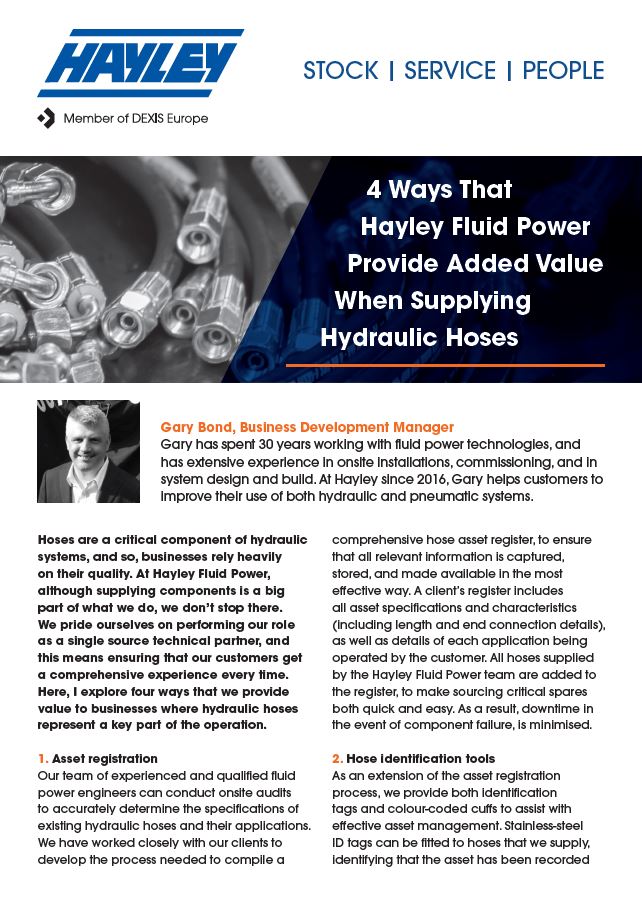by Gary Bond, Business Development Manager
Gary has spent 30 years working with fluid power technologies, and has extensive experience in onsite installations, commissioning, and in system design and build. At Hayley since 2016, Gary helps customers to improve their use of both hydraulic and pneumatic systems.
Hoses are a critical component of hydraulic systems, and so, businesses rely heavily on their quality. At Hayley Fluid Power, although supplying components is a big part of what we do, we don’t stop there. We pride ourselves on performing our role as a single source technical partner, and this means ensuring that our customers get a comprehensive experience every time. Here, I explore four ways that we provide value to businesses where hydraulic hoses represent a key part of the operation.
1. Asset registration
Our team of experienced and qualified fluid power engineers can conduct onsite audits to accurately determine the specifications of existing hydraulic hoses and their applications. We have worked closely with our clients to develop the process needed to compile a comprehensive hose asset register, to ensure that all relevant information is captured, stored, and made available in the most effective way. A client’s register includes all asset specifications and characteristics (including length and end connection details), as well as details of each application being operated by the customer. All hoses supplied by the Hayley Fluid Power team are added to the register, to make sourcing critical spares both quick and easy. As a result, downtime in the event of component failure, is minimised.
2. Hose identification tools
As an extension of the asset registration process, we provide both identification tags and colour-coded cuffs to assist with effective asset management. Stainless-steel ID tags can be fitted to hoses that we supply, identifying that the asset has been recorded in the register. The quality and durability of the tags means that operators or engineers can use them to quickly and easily identify assets both throughout and well beyond the hoses’ service life. The information provided by the tag helps to significantly reduce any operational downtime that may occur due to a fault or breakdown, as a replacement can be sourced rapidly.
We are also able to fit heat shrink colour-coded cuffs to the hoses we supply. These are usually fitted adjacent to the stainless-steel ID tags, and they provide another means of making the identification and management of hose assets more efficient for our customers. Again, it identifies the asset as one appearing on the register, and one which has been supplied to our own high standards, improving traceability. The colour-coded cuffs also prove to be a popular option when there are multiple hoses on a single machine, as they act as a visual distinguisher between assets.
We are also able to fit heat shrink colour-coded cuffs to the hoses we supply. These are usually fitted adjacent to the stainless-steel ID tags, and they provide another means of making the identification and management of hose assets more efficient for our customers. Again, it identifies the asset as one appearing on the register, and one which has been supplied to our own high standards, improving traceability. The colour-coded cuffs also prove to be a popular option when there are multiple hoses on a single machine, as they act as a visual distinguisher between assets.
3. Pressure testing and capping
When purchasing hoses through Hayley Group, businesses can be rest assured that the hoses being used within their facilities have been pressure tested and certified to all relevant standards. A logged and documented official test certificate can be provided to customers when required, for a very small additional cost. Generally, we find that this is a useful option for customers of which the hoses supplied represent part of a critical process application.
Hoses supplied by Hayley Group can be fitted with end caps. The capping of our hoses helps to prevent unwanted, and potentially dangerous contamination of the hoses before installation. End caps also help to protect hoses from any damage incurred during transportation and offloading, meaning that the integrity and quality of the product is maintained during delivery.
4. Cleaning and flushing
All of the hoses that Hayley Group supplies are bead cleaned and flushed in accordance with ISO standards (ISO 4407:1991) and to appropriate NAS levels. The result is that our hoses reach customer sites in a state of superior cleanliness when compared to the industry standard. Hose cleanliness is all too often overlooked, but to avoid contamination, it is important to have fully clean and flushed hoses at the point of use.
Our cleaning process involves the use of both a bead cleaning rig and a hydraulic flushing rig. The first of which is followed by compressed air cleaning, achieving a cleanliness level of NAS 4/5. The latter hydraulic flushing procedure achieves a NAS level of 1/2. This process is not a mandatory requirement of the British Fluid Power Association (BFPA) but is something that we have incorporated as part of our quality assurance regime, to continue to go above and beyond expectation.
Conclusion
In our supply of hydraulic hoses, we use our combined staff experience, excellent facilities, and abundant stock of market-leading products, to provide our customers with the best possible experience. Through the four points above, we help to ensure that hoses from Hayley Group are reliable and traceable, of optimal suitability for the application, are free from contamination, and also support effective asset management by our customers.



